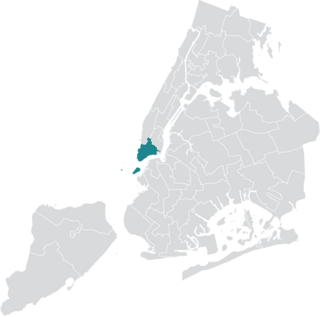
The Seattle City Council is the legislative body of the city of Seattle, Washington. The Council consists of nine members serving four-year terms, seven of which are elected by electoral districts and two of which are elected in citywide at-large positions; all elections are non-partisan. It has the responsibility of approving the city's budget, and passes all legislation related to the city's police, firefighting, parks, libraries, and electricity, water supply, solid waste, and drainage utilities. (The mayor of Seattle is not considered part of council.)

The mayor of New York City is elected in early November every four years, in the year immediately following a United States presidential election year, and takes office at the beginning of the following year. The city, which elects the mayor as its chief executive, consists of the five boroughs, which consolidated to form "Greater" New York on January 1, 1898.

The New York City Council is the lawmaking body of New York City in the United States. It has 51 members from 51 council districts throughout the five boroughs.

The city government of Atlanta, Georgia, United States, is composed of a mayor and a body of one councilman from each of 12 districts, a City Council President, and 3 other at-large councilmen:
The borough presidents are the chief executives of the five boroughs of New York City. For most of the city's history, the office exercised significant executive powers within each borough, and the five borough presidents also sat on the New York City Board of Estimate, which was abolished in 1990. After the Board of Estimate was disbanded, the borough presidents were stripped of a majority of their powers in the government of New York City.

The New York City Board of Estimate was a governmental body in New York City responsible for numerous areas of municipal policy and decisions, including the city budget, land-use, contracts, franchises, and water rates. Under the amendments effective in 1901, to the charter of the then-recently-amalgamated City of Greater New York, the Board of Estimate and Apportionment was composed of eight ex officio members: the Mayor of New York City, the New York City Comptroller and the President of the New York City Board of Aldermen, each of whom had three votes; the borough presidents of Manhattan and Brooklyn, each having two votes; and the borough presidents of the Bronx, Queens, and Richmond, each having one vote. The 1897 charter effective on amalgamation had had a five-member Board of Estimate and Apportionment. The La Guardia Reform Charter of 1938 simplified its name and enhanced its powers.

New York City's 1st City Council district is one of 51 districts in the New York City Council. It is currently represented by Democrat Christopher Marte, who took office in 2022.

The New York City Board of Aldermen was a body that was the upper house of New York City's Common Council from 1824 to 1875, the lower house of its Municipal Assembly upon consolidation in 1898 until the charter was amended in 1901 to abolish the Municipal Assembly and its upper house, and its unicameral legislature from 1875 to 1897 and 1902 to 1937. The corresponding lower house was known as the Board of Assistants or the Board of Assistant Aldermen from 1824 to 1875, while the upper house was known as the Council from 1898 to 1901. In 1938 a new charter came into effect that replaced the Board of Aldermen with the New York City Council.

Elections were held on November 2, 1937 to fill the New York City Council, which had just been formed to replace the New York City Board of Aldermen. The new Council comprised 26 members elected via proportional representation by borough, in contrast to the 65-member Board of Aldermen elected by district. This was done in response to the large majorities the Democrats often received in the Board of Aldermen. Each borough was entitled to one member of the council for each 75,000 votes cast, and an additional member for each remainder greater than 50,000. Due to voter turnout, Brooklyn was entitled to nine members of the Council, Manhattan six, Queens and The Bronx five each, and Richmond one.

Elections were held to fill the 65 seats of the New York City Board of Aldermen on November 5, 1935. They would be the final elections to the Board of Aldermen, which would be abolished in 1937 in favor of the New York City Council, which was elected via borough-wide proportional representation.

An election was held on November 5, 1929, to elect the President of the New York City Board of Aldermen, in concert with other such contests as the mayoralty, Comptroller, the remainder of the Board of Aldermen, County Sheriffs, Borough presidents, and other miscellaneous questions on the ballot. Democratic incumbent Joseph V. McKee of The Bronx defeated Republican candidate Bird Sim Coler of Brooklyn, himself an independent Democrat, 890,655 votes to 385,514. This combined with Democratic victories in other contests formed what was considered "a Crushing Defeat to [the] City G.O.P. [delivered]" by Tammany Hall.

Elections for New York City's borough presidents were held on November 2, 1897. The City of Greater New York, as the newly enlarged New York City was colloquially known, had been created from what had been New York City, Richmond County, Kings County, and the western part of Queens County. The city was then divided into five boroughs, which each elected a borough president every four years.

An election was held on November 7, 1933 to elect the President of the New York City Board of Aldermen, along with other contests such as the mayoralty, Comptroller, and aldermen. Democratic incumbent Joseph V. McKee had resigned earlier in the year to assume the office of Mayor after Jimmy Walker had resigned that position, and the aldermanic presidential post was occupied by Dennis J. Mahon in the meantime. Republican candidate Bernard S. Deutsch defeated Democratic candidate Milton Solomon and Recovery Party candidate Natan Straus Jr. to win the position.

An election was held on November 8, 1927 to fill the 72 seats of the New York City Board of Aldermen, in addition to elections to the New York State Assembly and various other questions on the ballot. 66 Democrats and 6 Republicans were elected to the Board. Brooklyn lost its sole Republican alderman.

An election was held to fill the Municipal Assembly of the newly created City of Greater New York on November 2, 1897. The charter of the new city had created a bicameral Municipal Assembly, consisting of an upper Council and a lower Board of Aldermen. Each chamber was elected from specially-made districts. In addition, the president of the Council was elected in a separate election on the same day.

The 1929 New York City mayoral election was held on November 5 in concert with other municipal elections. Democratic incumbent Jimmy Walker defeated Republican challenger Fiorello H. La Guardia in what was considered "a Crushing Defeat to [the] City G.O.P. [delivered]" by Tammany Hall. Socialist candidate Norman Thomas also ran, as did Socialist Labor candidate Olive M. Johnson and former Police Commissioner Richard Edward Enright for the Square Deal Party.
Augustus F. Pierce was an American politician who served as the Tammany Hall leader of the Bronx's 8th assembly district in New York City until his death in 1934. An employee of the city since 1907, at the time of his death he worked for the Department of Sanitation.

New York City was divided into wards between 1683 and 1938. These were used for the election of various municipal offices, and would later be used to construct the boundaries of larger electoral districts. Prior to the formation of the so-called City of Greater New York in 1898, what is now New York City comprised multiple municipalities that had different histories with wards.

Lyman Williams Redington was an American attorney and politician who was active in Vermont and New York. A Democrat, he served in the Vermont House of Representatives from 1880 to 1882, and the New York State Assembly from 1898 to 1900. In addition, as a Democrat during the more than 100 years when Republicans won every statewide election and contest for federal office, Redington was also an unsuccessful candidate for Vermont's 1st district seat in the United States House of Representatives in 1882, and governor of Vermont in 1884.












